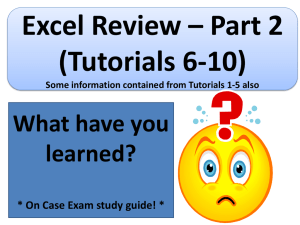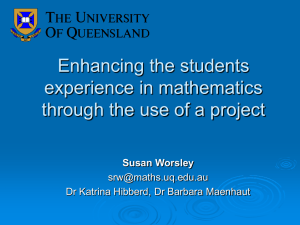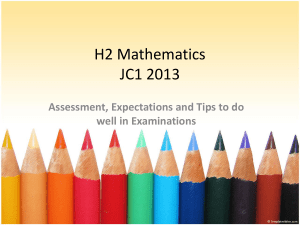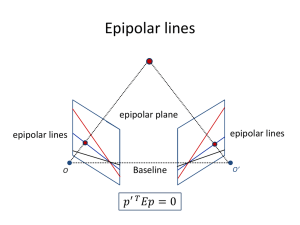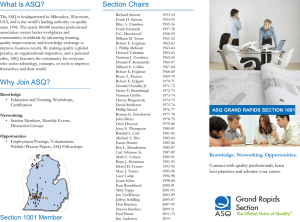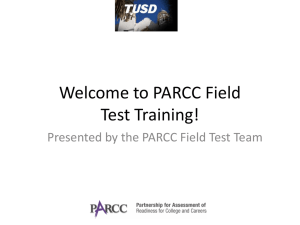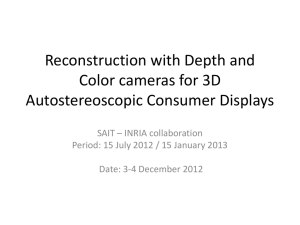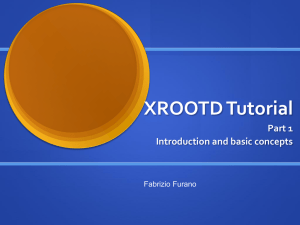MLA2011poster - University of Minnesota Twin Cities
advertisement
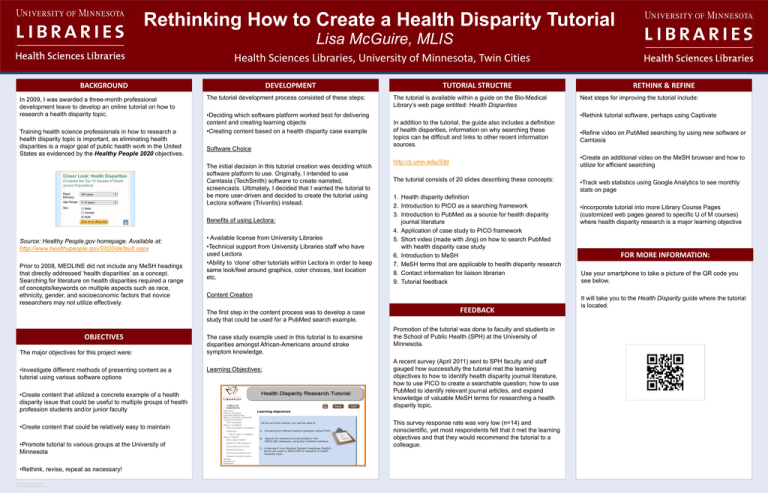
Rethinking How to Create a Health Disparity Tutorial Lisa McGuire, MLIS Health Sciences Libraries, University of Minnesota, Twin Cities BACKGROUND In 2009, I was awarded a three-month professional development leave to develop an online tutorial on how to research a health disparity topic. Training health science professionals in how to research a health disparity topic is important, as eliminating health disparities is a major goal of public health work in the United States as evidenced by the Healthy People 2020 objectives. DEVELOPMENT The tutorial development process consisted of these steps: •Deciding which software platform worked best for delivering content and creating learning objects •Creating content based on a health disparity case example Software Choice The initial decision in this tutorial creation was deciding which software platform to use. Originally, I intended to use Camtasia (TechSmith) software to create narrated, screencasts. Ultimately, I decided that I wanted the tutorial to be more user-driven and decided to create the tutorial using Lectora software (Trivantis) instead. Benefits of using Lectora: Source: Healthy People.gov homepage. Available at: http://www.healthypeople.gov/2020/default.aspx Prior to 2008, MEDLINE did not include any MeSH headings that directly addressed ‘health disparities’ as a concept. Searching for literature on health disparities required a range of concepts/keywords on multiple aspects such as race, ethnicity, gender, and socioeconomic factors that novice researchers may not utilize effectively. • Available license from University Libraries •Technical support from University Libraries staff who have used Lectora •Ability to ‘clone’ other tutorials within Lectora in order to keep same look/feel around graphics, color choices, text location etc. The major objectives for this project were: •Investigate different methods of presenting content as a tutorial using various software options •Create content that utilized a concrete example of a health disparity issue that could be useful to multiple groups of health profession students and/or junior faculty •Create content that could be relatively easy to maintain •Promote tutorial to various groups at the University of Minnesota •Rethink, revise, repeat as necessary! RESEARCH POSTER PRESENTATION DESIGN © 2011 www.PosterPresentations.com The tutorial is available within a guide on the Bio-Medical Library’s web page entitled: Health Disparities The case study example used in this tutorial is to examine disparities amongst African-Americans around stroke symptom knowledge. Learning Objectives: RETHINK & REFINE Next steps for improving the tutorial include: •Rethink tutorial software, perhaps using Captivate In addition to the tutorial, the guide also includes a definition of health disparities, information on why searching these topics can be difficult and links to other recent information sources. •Refine video on PubMed searching by using new software or Camtasia http://z.umn.edu/33d •Create an additional video on the MeSH browser and how to utilize for efficient searching The tutorial consists of 20 slides describing these concepts: 1. Health disparity definition 2. Introduction to PICO as a searching framework 3. Introduction to PubMed as a source for health disparity journal literature 4. Application of case study to PICO framework 5. Short video (made with Jing) on how to search PubMed with health disparity case study 6. Introduction to MeSH 7. MeSH terms that are applicable to health disparity research 8. Contact information for liaison librarian 9. Tutorial feedback Content Creation The first step in the content process was to develop a case study that could be used for a PubMed search example. OBJECTIVES TUTORIAL STRUCTRE FEEDBACK Promotion of the tutorial was done to faculty and students in the School of Public Health (SPH) at the University of Minnesota. A recent survey (April 2011) sent to SPH faculty and staff gauged how successfully the tutorial met the learning objectives to how to identify health disparity journal literature, how to use PICO to create a searchable question, how to use PubMed to identify relevant journal articles, and expand knowledge of valuable MeSH terms for researching a health disparity topic. This survey response rate was very low (n=14) and nonscientific, yet most respondents felt that it met the learning objectives and that they would recommend the tutorial to a colleague. •Track web statistics using Google Analytics to see monthly stats on page •Incorporate tutorial into more Library Course Pages (customized web pages geared to specific U of M courses) where health disparity research is a major learning objective FOR MORE INFORMATION: Use your smartphone to take a picture of the QR code you see below. It will take you to the Health Disparity guide where the tutorial is located.



